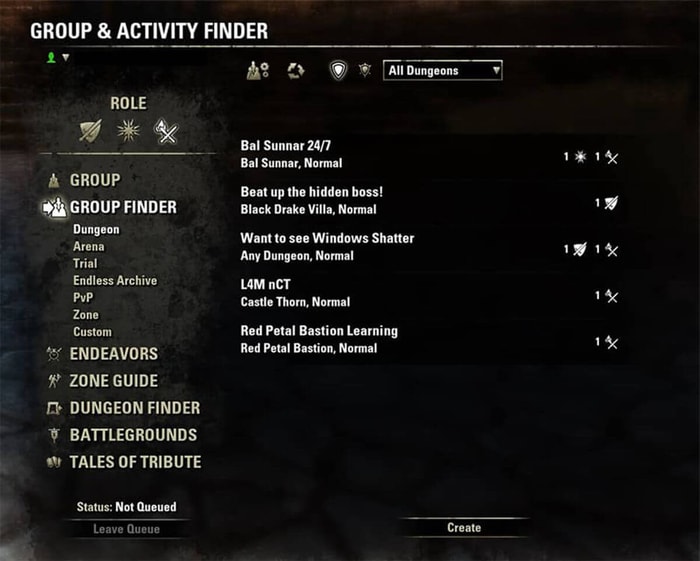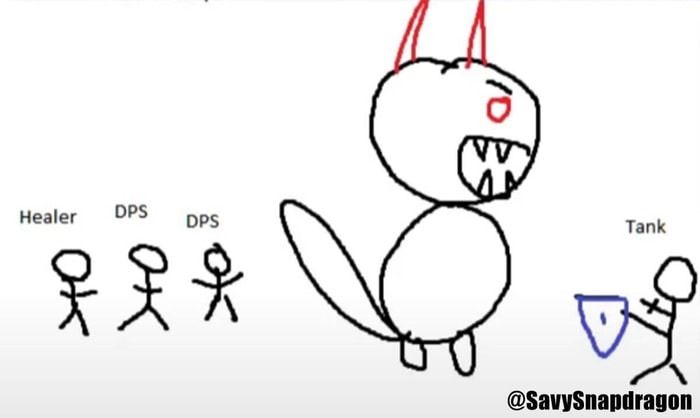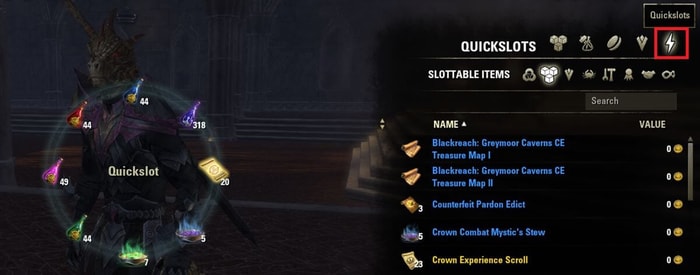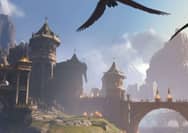Group content in The Elder Scrolls Online is any activity that requires or benefits from playing with other players. It can be challenging and rewarding, as well as fun and social. TESO provides different group content for you to explore. If you prefer team play or want to get more in-game money in TESO by playing dungeons and trials, SavySnapdragon shares some essential things you should know before participating in group content. This guide covers some unstated rules within the community and tips that you will find useful.
Roles
In group content, when you assign yourself to a particular role, there are certain expectations of what you should contribute to the team. Here are the key role features for the three roles in ESO:
• Tanks need to be able to taunt enemies, group up adds, and focus on buffing teammates and debuffing enemies.
• Healers need to heal teammates, buff teammates, and debuff enemies.
• Damage Dealers (DPS) focus on doing damage.
Swapping Roles

The new Group Finder tool that is coming with Update 40 of ESO
When playing group content in ESO, it is important to change your in-game role to match what you're doing. To do this, navigate to the Group and Activity Finder (press the [P] key if you play on a PC/Mac). Once there, you will notice three icons representing the different roles in the game:
• Tank (a sword and shield)
• Healer (a star)
• DPS (a cross with a sword and staff)
To switch between these roles, simply click on the icon of the role you want to play. There is no cooldown time between role changes, but keep in mind that each role comes with its own set of responsibilities when playing with a group.
Resurrection
In group content in ESO, there is an unstated rule regarding who should perform a resurrection. Generally, it is preferred that DPS players should be the first to attempt a resurrection, followed by Healers and then Tanks. This order of preference is based on the following reasoning:
If Tanks try to resurrect, they would be locked into a non-blocking position for six seconds, which is a risk as they need to maintain taunt on the boss and may get killed or interrupted by the enemies. If Healers try to resurrect, they would be unable to provide healing for six seconds, which may lead to others dying due to lack of support. If a DPS player attempts a resurrection, they may lock themselves out of dealing damage for six seconds, but Healers can focus their efforts on keeping them safe, and Tanks can keep the enemies away from them. Therefore, the safest way to perform a resurrection is by having a DPS player do it.
Positioning

A general positioning recommendation for each role in group content of ESO
When it comes to positioning in most content, the Tank's role is to taunt and hold the boss, while the DPS should be positioned behind the boss's back. Healers, on the other hand, should be positioned behind the DPS but still close enough to the Tank to ensure they receive consistent heals. This formation enables buffs from Tanks and Healers to reach the DPS while also pointing the boss away from the group. However, please note that this is a general recommendation, and knowing the mechanics of a fight might require a different formation for positioning. Nonetheless, this formation is a safe bet when in doubt.
Tank First
In ESO, it is important to follow proper group content etiquette. When encountering a group of enemies, whether it be a boss fight or smaller enemies, it is important to let the Tank be the first to start the encounter. This unstated rule allows for cleaner pulls and helps ensure everyone's safety. If someone other than the Tank runs in first, the boss might hit a random player since the AI of the enemies randomly picks a target when there is no taunt on them.
When there are multiple enemies, it is best to let the Tank pull first as it ensures they can clearly taunt the enemies of high danger before the group gets shuffled up. It can even allow the Tank to more easily group and snare enemies. Following this etiquette ensures everyone has a better chance of surviving group encounters. Therefore, be kind to your Tank and let them start the pulls at their pace.
Chests
In ESO, Dungeons and Trials are filled with Treasure Chests. Unlike Overland chests, everyone in the group can loot chests in group content, and everyone has a unique instance of loot. These chests have a chance to contain the gear sets of that particular group content.
The common etiquette in ESO is to type "chest" in a group chat when you find a chest and then stand there until your teammates see you. Not everyone is going to loot the chest, but if you look at your map and see someone coming back to loot, just stand by the chest and maybe even attack it a few times to show its position.
Dungeon Quests
Every dungeon has a quest that can be picked up at the beginning of the instance. Upon completion, you get a Skill Point and a piece of gear. Usually, if you are with the pickup group (PUG) and want to get really into the story of a dungeon, it's recommended not to pick the quest up. This is because you might feel pressured to rush through the story with a group of other players who just want to complete the dungeon as quickly as possible.
If you don't care about the story and just want the extra Skill Point, grab the quest and type "doing quest" in the group chat. In certain dungeons, there are extra bosses you need to do for the quest, so it is helpful to let your teammates know.
Baby Character
In The Elder Scrolls Online, you may come across players offering "baby random normals" or "easy random normals". Wondering what these terms mean? Well, in ESO, a character below level 45 is generally referred to as a "baby character". That being said, higher-level players often offer baby characters Guild or Zone chats for easy random normals.
This is because of ESO's dungeon queue system. If your group has a player below level 45, your group will not get a DLC dungeon. The queue system will only select from the dungeons that all players in the group can participate in.
Usually, players consider the base-game dungeons to be easier than the DLC dungeons. Therefore, if you're a new player and you've just hit level 10, don't hesitate to join group content. There are veteran players willing to help out with easy random normals, even if you're playing with a "baby character".
Buff Food
When engaging in group content in ESO, it is essential that all players use buff food. This is just as important as wearing gear and is a fundamental part of your build.
Buff food is a consumable item that comes in the form of food or drink. It can provide a significant boost to your maximum resource pools of Health, Stamina, or Magicka. Additionally, they can also increase your regeneration of these resources.
No one buff food can increase everything. Therefore, you have to choose which aspects you want. When deciding what to use, it is recommended to look up builds for your desired class and roles and see what other content creators recommend.
There are hundreds of recipes in ESO, making choosing overwhelming to those unfamiliar with all the options. When in doubt, going with a food that gives you more maximum Health, more maximum resource, and more resource generation is always a solid choice.
Potions
When doing group content in ESO, players should use potions. Although potions can provide a short burst of resources, they can also aid with resource regeneration, preventing you from running out in the first place. Therefore, it's better to consider them as a preventative measure, rather than a reactionary one.

Equipping items to the Quickslots
To use potions in combat, make sure to equip them to your Quickslots as follows:
1. Press [I] to bring up your inventory.
2. Click the Lighting bolt icon in the upper right corner to pull up the Quickslot menu.
3. Select the potion you want to add and drag it to the desired Quickslot location.
The icon that looks like three boxes is the tab where slottable items are listed.
To use a Quickslot potion:
1. Press and hold the [Q] key to access your Quickslot menu
2. Mouse over the option you wish to use and release the [Q] key
3. Now, when you quickly press the [Q] key, you will use your selected potion.
Which potion type to use can be daunting with all the options. But a great start is the free Crown Tri-Restoration Potion you get for login. You don't have to worry about crafting potions until you want to really get into harder content. Just getting in the habit of having some in the inventory and Quickslots is a great first step.
Passives
Some passives can increase the duration of food and potion:
• Gourmand (Provisioning skill line) adds up to 20 minutes to the duration of any eaten food.
• Connoisseur (Provisioning skill line) adds up to 20 minutes to the duration of any consumed drink.
• Rationer (Craft CP tree) can add up to 30 minutes to the duration of any food or drink that increases your character's stats.
• Medicinal Use (Alchemy skill line) increases the duration of the potion you are using by 30%.
Buffs and Debuffs
Buffs and debuffs are temporary character effects applied by abilities, gear sets, or potions. Buffs are applied to yourself or your allies, while debuffs are applied to enemies. It is important to note that two buffs or debuffs with the same name will not stack. However, a Major and a Minor buff or debuff of the same type will stack. Understanding this core concept will help with group optimization. Here are a few examples to help illustrate how it works:
Example 1: During a Trial, if one healer is wearing Spell Power Cure and the other is wearing Vestment of Olorime, then both healers are applying the same buff of Major Courage. This makes one of the sets redundant, as the effect does not stack.
Example 2: When a Healer wears Spell Powered gear and a Tank wears Claw of Yolnahkriin, the group gets both Major and Minor Courage because they stack.
Stacking Buffs
Buff can be stacked with a bit of coordination within the group. Many buffs can go towards the same goal. Here is an example:
Spell Power Cure: + 430 Weapon and Spell Damage
Claw of Yolnahkriin: + 215 Weapon and Spell Damage
Powerful Assault: + 289 Weapon and Spell Damage
Pearlescent Ward: + 170 Weapon and Spell Damage
Spaulder of Ruin: + 260 Weapon and Spell Damage
Total Weapon and Spell Damage: 1364
Please note that this is just a theoretical example and not an exact representation of what one may encounter in group content. It simply illustrates how it's possible to combine various sources to achieve the same goal of increasing Weapon and Spell damage.
Those are the 13 quick tips for group content in ESO. If you found this guide helpful, please don't forget to give the video a thumbs up and subscribe to SavySnapdragon's channel.
YOU MAY ALSO LIKE:
ESO's Update 40 Introduces New PvE Activity: Endless Archive
Update 40 of ESO: A Comprehensive Overview
Must-Have Skills for a Healer in ESO



